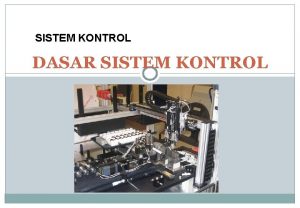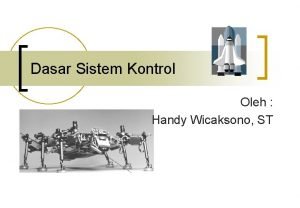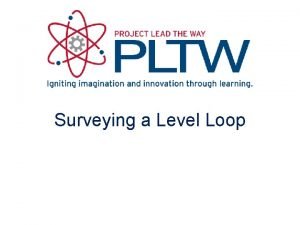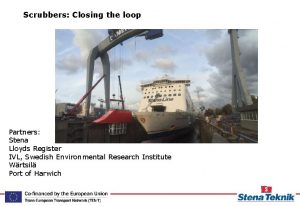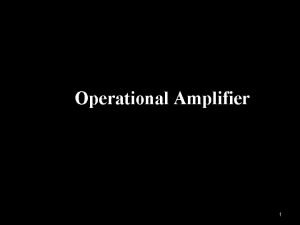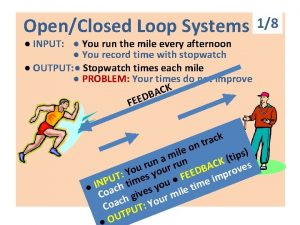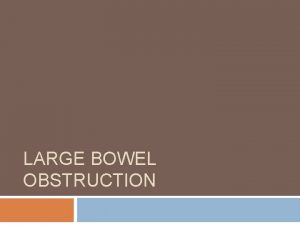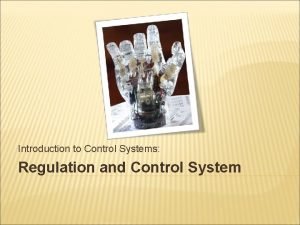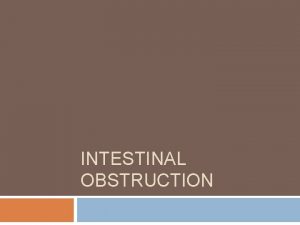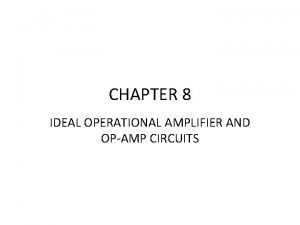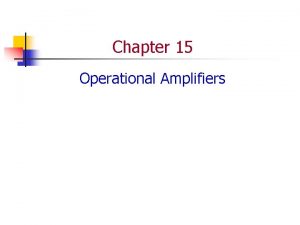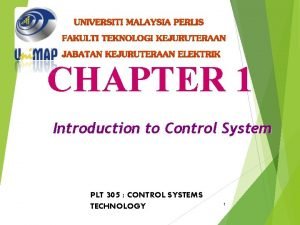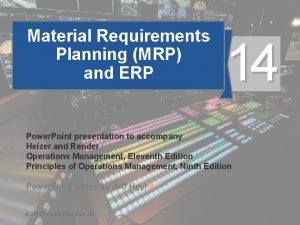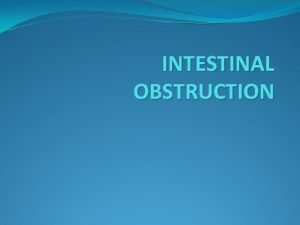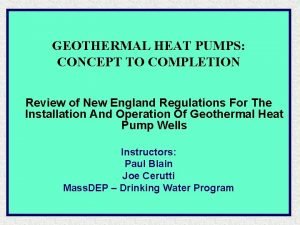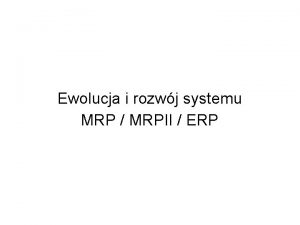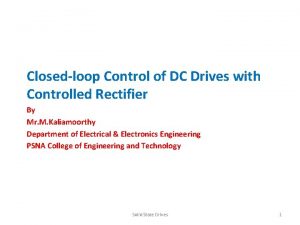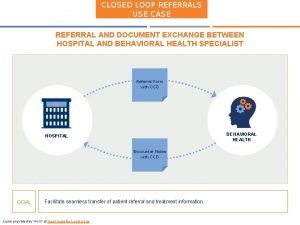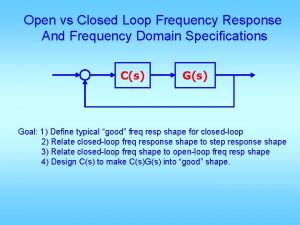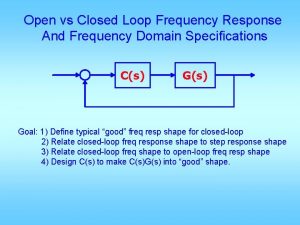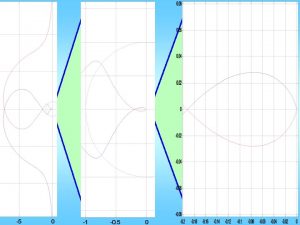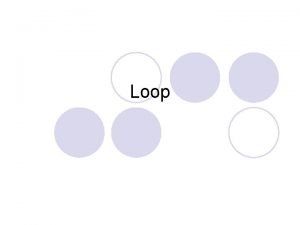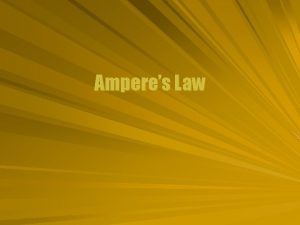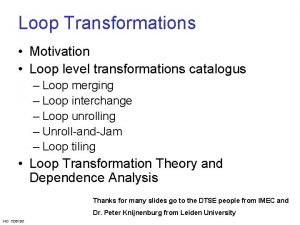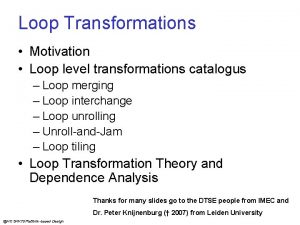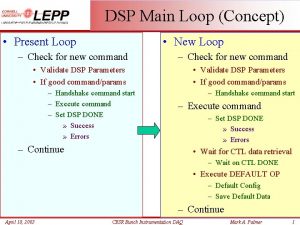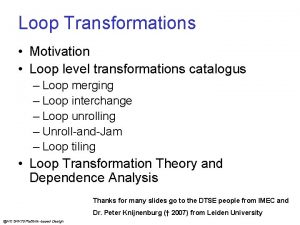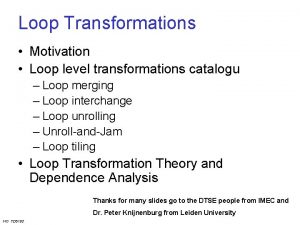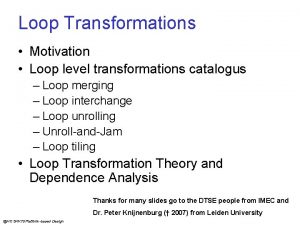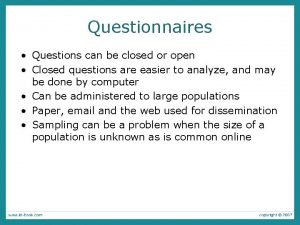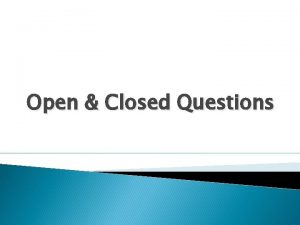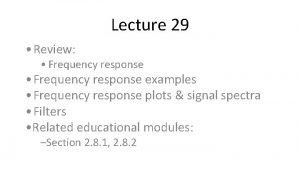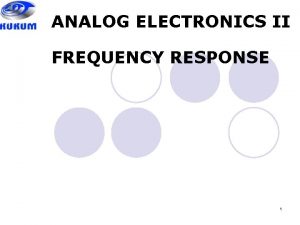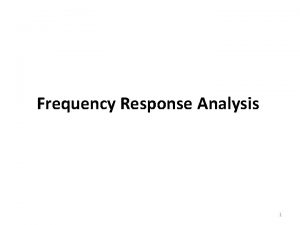Open vs Closed Loop Frequency Response And Frequency





















- Slides: 21

Open vs Closed Loop Frequency Response And Frequency Domain Specifications C(s) Goal: 1) Define typical “good” frequency response shape for closed-loop 2) Relate closed-loop freq response shape to step response shape 3) Relate closed-loop freq shape to open-loop freq response shape 4) Design C(s) to make C(s)G(s) into “good” shape.

Mr and BW are widely used Closed-loop phase resp. rarely used

Prototype 2 nd order system closed-loop frequency response No resonance for z <= 0. 7 Mr=0. 3 d. B for z=0. 6 z=0. 1 Mr=1. 2 d. B for z=0. 5 0. 2 For small zeta, resonance freq is about wn 0. 3 Mr=2. 6 d. B for z=0. 4 BW ranges from 0. 5 wn to 1. 5 wn For good z range, BW is 0. 8~1. 25 wn -3 d. B BW 0. 63 So take BW ≈ wn 1. 58 0. 79 20*log 10(abs(1/((jw)^2+2*z*w+1))) 1. 26 w/wn

Closed-loop BW to wn ratio BW≈(2 -1. 4 z)wn BW/wn BW≈wn z

Prototype 2 nd order system closed-loop frequency response z=0. 1 When z >=0. 6 no visible resonance peak 0. 2 0. 3 When z <=0. 5 visible resonance peak near w=wn Since we design for z >=0. 5, Mr and wr are of less value No resonance for z <= 0. 7 Mr<0. 5 d. B for z=0. 6 Mr=1. 2 d. B for z=0. 5 Mr=2. 6 d. B for z=0. 4 w=wn w/wn

Prototype 2 nd order system closed-loop frequency response Mr vs z Mr = 1 + 0. 7(z-0. 7)

Mr in d. B

Percentage Overshoot in closed-loop step response z > 0. 5 is good z

Percentage Overshoot in closed-loop step response Mp Mr < 15% is good, >40% not tolerable Mr

Percentage Overshoot in closed-loop step response Mr < 1. 5 d. B is good, >3 d. B not tolerable Mp% = 6 + 8 Mrd. B Mr in d. B

z=0. 1 0. 2 0. 3 0. 4 Open loop frequency response wgc In the range of good zeta, wgc is about 0. 7 times wn w/wn

Open-loop wgc to wn ratio wgc≈0. 7 wn z

z=0. 1 In the range of good zeta, PM is about 100*z 0. 2 0. 3 0. 4 w/wn

Phase Margin PM = 100 z z

Percentage overshoot: Mp PM+Mp =70 line Percentage Overshoot in closed-loop step response Phase Margin in degrees: PM in deg

Important relationships • Closed-loop BW are very close to wn • Open-loop gain cross over wgc ≈ (0. 65~0. 8)* wn, • When z <= 0. 6, wr and wn are close • When z >= 0. 7, no resonance • z determines phase margin and Mp: z PM Mp 0. 4 0. 5 0. 6 0. 7 44 53 61 25 16 10 PM+Mp ≈70 67 5 deg % ≈100 z

Mid frequency requirements • wgc is critically important – It is approximately equal to closed-loop BW – It is approximately equal to wn • Hence it determines tr, td directly • PM at wgc controls overshoot and z – Mp 70 – PM • PM and wgc together controls s and wd – Determines ts, tp • Need wgc at the right frequency, and need sufficient PM at wgc

Low frequency requirements • Low freq gain slope and/or phase determines system type • Height at low frequency determine error constants Kp, Kv, Ka • Which in turn determine ess • Need low frequency gain plot to have sufficient slope and sufficient height

High frequency requirements • Noise is always present in any system • Noise is rich in high frequency contents • To have better noise immunity, high frequency gain of system must be low • Need loop gain plot to have sufficient slope and sufficiently small value at high frequency

Desired Bode plot shape Ess requirement 0 d. B High low-freq-gain for steady state tracking Low high-freq-gain for noise attenuation Sufficient PM near wgc for stability wgcd Mid frequency Noise requirement w 0 -90 -180 w PMd

Controller design with Bode C(s) Gp(s) From specs: => desired Bode shape of Gol(s) Make Bode plot of Gp(s) Add C(s) to change Bode shape as desired Get closed loop system Run step response, or sinusoidal response Modify controller as needed
 Open loop vs closed loop in cars
Open loop vs closed loop in cars Diagram blok pemanggang roti
Diagram blok pemanggang roti Manakah yang lebih baik open loop atau close loop system
Manakah yang lebih baik open loop atau close loop system Off delay timer symbol
Off delay timer symbol Open innovation open science open to the world
Open innovation open science open to the world Level loop surveying
Level loop surveying Closed loop scrubber
Closed loop scrubber Gain bandwidth product of op amp
Gain bandwidth product of op amp Closed system example
Closed system example Dynamic obstruction intestine
Dynamic obstruction intestine Missile launcher closed-loop system
Missile launcher closed-loop system Dynamic and adynamic intestinal obstruction
Dynamic and adynamic intestinal obstruction Closed loop kommunikation
Closed loop kommunikation Ideal op
Ideal op Slew rate formula of op amp
Slew rate formula of op amp Missile launcher closed-loop system
Missile launcher closed-loop system Explain mrp
Explain mrp Large vs small bowel obstruction
Large vs small bowel obstruction Open loop geothermal well massachusetts
Open loop geothermal well massachusetts Mrpii
Mrpii Closed loop control of dc drives
Closed loop control of dc drives Closed loop referral system
Closed loop referral system

